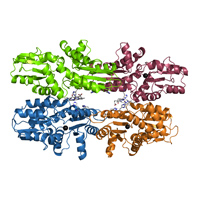
Modified tetrapyrroles are key elements for life since they serve as cofactors and pigments in several biological processes. Well-known examples are hemes, siroheme, vitamin B12, coenzyme F430 and chlorophyll, whose assembly requires insertion of a specific metal ion into the tetrapyrrolic structure, via chelatase enzymes. Cobaltochelatases act in the vitamin B12 biosynthetic pathway, cobalt being inserted into the tetrapyrrole ring.
The X-Ray crystallographic structure from the cobaltchelatase CbiKP from Desulfovibrio vulgaris was determined, and this is the first structure of a cobalt-loaded cobaltochelatase revealing the aminoacid residues involved on the cobalt binding.
Furthermore, the protein structure revealed some new features on the chelatase superfamily: tetrameric oligomerization with a heme b cofactor located at the interface between two monomers. The tetramer is organized in such a way that a central cavity with the potential for ligand binding is formed. The structure suggests that the cobaltochelatase CbiKP of D. vulgaris may have evolved an additional function, such as the transport of metals across the periplasmic space.
References
C.V. Romão, D. Ladakis, S.A.L. Lobo, M.A. Carrondo, A.A. Brindley, E. Deery, P.M. Matias, R.W. Pickersgill, L.M. Saraiva and M.J. Warren, “Evolution in a family of chelatases facilitated by the introduction of active site asymmetry and protein oligomerization”, PNAS (2011), 108(1): 97-102